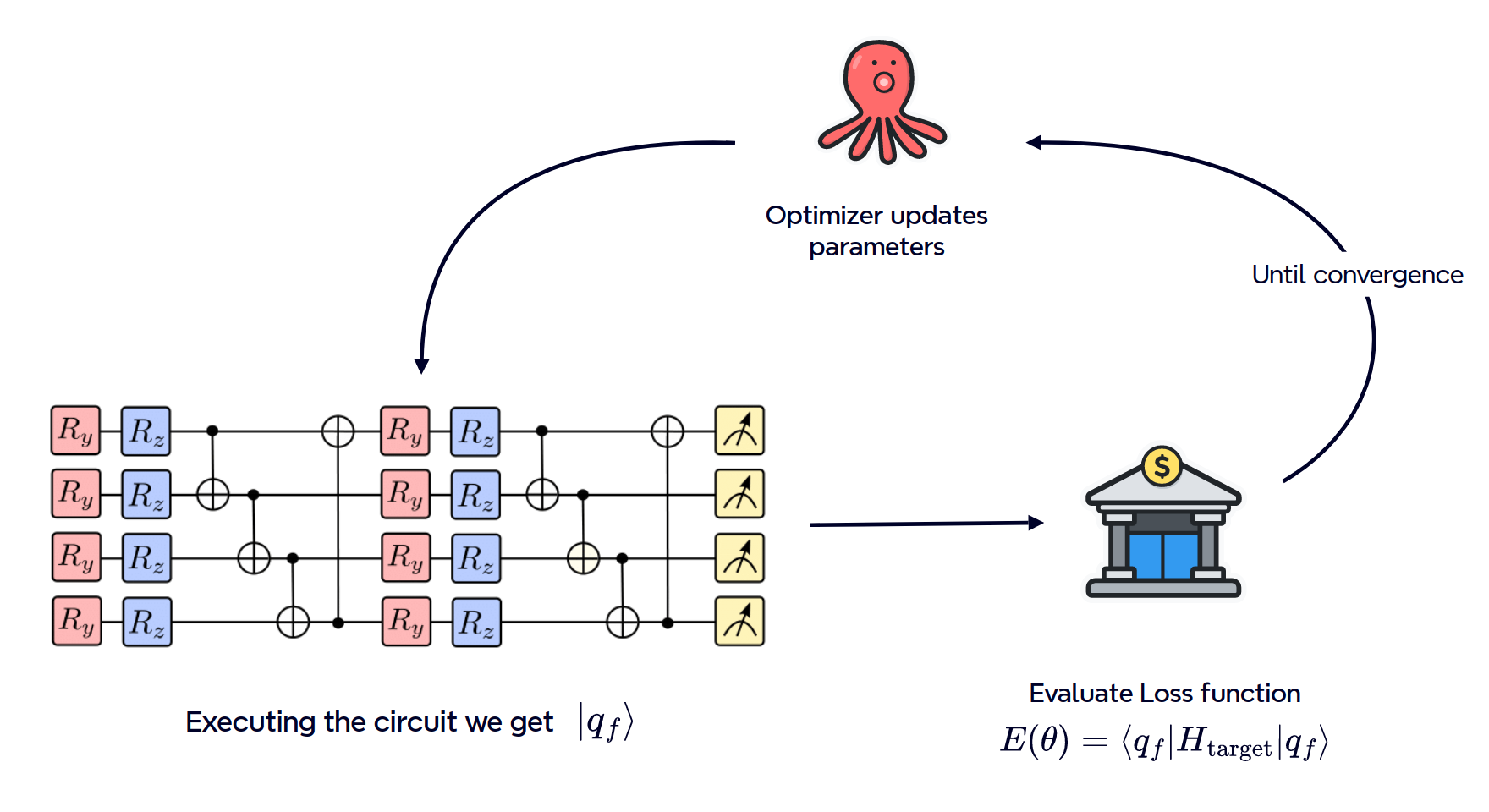Variational Quantum Eigensolver#
A variational quantum eigensolver is a variational quantum algorithm where a parametrized quantum circuit is trained to prepare the ground state of a target Hamiltonian See A. Peruzzo et al. - 2013.

As sketched above, the idea is that we get a state from a quantum circuit, and this state depends on the parameters of the circuit. Then we implement a machine learning routine to update the parameters of the circuit such that the expectation value of our target Hamiltonian on this state is minimized.
Some imports#
[ ]:
import numpy as np
import torch.optim as optim
from qibo import (
Circuit,
gates,
hamiltonians,
set_backend,
construct_backend,
)
from qiboml.models.decoding import Expectation
from qiboml.interfaces.pytorch import QuantumModel
The chosen model#
We choose a layered model, where a parametric structure composed of rotations and controlled rotations is repeated nlayers times.
[3]:
# Setting number of qubits of the problem and number of layers.
nqubits = 4
nlayers = 3
[4]:
# Structure of the VQE ansatz
def build_vqe_circuit(nqubits, nlayers):
"""Construct a layered, trainable ansatz."""
c = Circuit(nqubits)
for _ in range(nlayers):
for q in range(nqubits):
c.add(gates.RY(q=q, theta=np.random.randn()))
c.add(gates.RZ(q=q, theta=np.random.randn()))
[c.add(gates.CRX(q0=q%nqubits, q1=(q+1)%nqubits, theta=np.random.randn())) for q in range(nqubits)]
return c
Choice of the target#
As target, we select a one-dimensional Heisenberg Hamiltonian with gap set to \(\Delta=0.5\).
[5]:
# Define the target Hamiltonian
set_backend("qiboml", platform="pytorch")
hamiltonian = hamiltonians.XXZ(nqubits=nqubits, delta=0.5)
[Qibo 0.2.18|INFO|2025-05-19 18:24:38]: Using qiboml (pytorch) backend on cpu
This choice has to be provided to our decoding layer. In fact, our loss function will be exactly the output of this decoding: the expectation value of the given observable (the target Hamiltonian) over the final state prepared by the quantum model.
[6]:
# Construct the decoding layer
decoding = Expectation(
nqubits=nqubits,
observable=hamiltonian,
)
Building the whole model#
Our quantum model will present a circuit structure corresponding to our layered ansatz and an expectation value as decoding strategy.
[7]:
model = QuantumModel(
circuit_structure=build_vqe_circuit(nqubits=nqubits, nlayers=nlayers),
decoding=decoding,
)
_ = model.draw()

Let’s train!#
[8]:
print("Exact ground state: ", min(hamiltonian.eigenvalues()))
Exact ground state: tensor(-6.7446, dtype=torch.float64)
[9]:
optimizer = optim.Adam(model.parameters(), lr=0.05)
for iteration in range(300):
optimizer.zero_grad()
cost = model()
cost.backward()
optimizer.step()
if iteration % 20 == 0:
print(f"Iteration {iteration}: Cost = {cost.item():.6f}")
Iteration 0: Cost = -0.471007
Iteration 20: Cost = -5.387961
Iteration 40: Cost = -5.990623
Iteration 60: Cost = -6.153267
Iteration 80: Cost = -6.369555
Iteration 100: Cost = -6.604546
Iteration 120: Cost = -6.710510
Iteration 140: Cost = -6.738690
Iteration 160: Cost = -6.743156
Iteration 180: Cost = -6.743962
Iteration 200: Cost = -6.744113
Iteration 220: Cost = -6.744190
Iteration 240: Cost = -6.744234
Iteration 260: Cost = -6.744262
Iteration 280: Cost = -6.744281
We got it 🥳 !